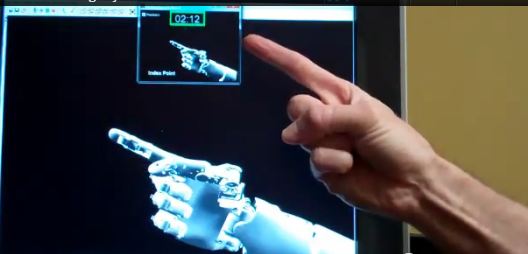TEAM DESIGN CHALLENGE | Start by Feb 22, Finish by April 1, 2013
Apply by February 15, 2013
- Do you have experience playing and/or making games?
- Are you interested in gesture recognition as input for game design?
- Can you name at least one character in Star Wars who was fitted with a prosthetic limb?
- Are you interested in making games for rehabilitation?
- Do you enjoy solving real-world problems?
If you answered YES to one or more of these questions and you are a USC student (undergrad/grad/doctoral), you can apply to participate in this design challenge. Below are the application requirements:
Email mgotsis [at] cinema.usc.edu with the following:
- a link or attachment to your cv or resume (include all creative/technical skills)
- a link to your portfolio and/or publications
- a 150-word statement on why you are interested in this project and what you think you can contribute
- your time availability/class/work/schedule (projects will require team-based work and meetings)
“Rock, Paper, Scissors” Team Design Challenge FAQ
What is this challenge really about?
We are collaborating with a company developing a kit for training individuals who have suffered amputation and who want to use new prosthetic arm technology. Star Wars technology is now available to consumers and it is very promising. Arm prosthetics have advanced a lot in recent years to support multiple degrees of freedom (not just open/closed hand). Our world is getting closer and closer to a mechanical arm like Luke Skywalker’s, but the skill lies in training the users to control their mechanical hand. Training takes many hours to complete and can be tiring and/or boring. Coming to specialized places to get training is difficult and costly. You can help!
The technology we are using is featured in the following videos and articles:
60 minutes YouTube video | MyoTrain | Baltimore Sun article
Our partners are Infinite Biomedical Technologies in Baltimore and the Medstar National Rehabilitation Hospital in Washington, D.C. This project is sponsored by the National Institutes of Health.
How will this challenge be met?
Based on the application pool we will convene 2-3 small multidisciplinary teams of students (8 people max). Students may be artists, designers, engineers, programmers, physical/occupational therapists, biokinesiologists, social scientists, etc. We need creative/technical/analytical people who can alternate between being spontaneous and methodical.
Teams will have 5 weeks to design and develop paper and digital prototypes of games that can help train amputees control their new prosthetic hand. The game design must be driven by the need to invoke and repeat 5 hand gestures for training purposes. There are some other requirements, such as resting and of course, enjoyment 🙂
Teams will be provided with all design requirements. Team-members with software programming experience can interface directly with the software (ideally via a Unity Engine executable). The amputees will be using a training kit of software connected to electromyography sensors (EMG). We have a kit, but we can’t loan it out because it is an expen$ive prototype. You will be able use it when you meet with us so we can test ideas together.
Teams will have access to patients who will give input to ideas and try any playables. Prototypes will also be evaluated by clinicians, scientists, engineers, patients and members of the Creative Media & Behavioral Health Center.
The most promising prototype(s) will be further developed and polished for another 5 weeks and evaluated in a clinical study of 4-5 patients who will be newly fitted with prosthetic devices at Medstar National Rehabilitation Hospital.
What is in it for me?
- Each team member will be given a stipend or gift certificate ($50/per week, up to $300 per person) for participating in the team design challenge.
- You will earn valuable experience within a diverse design team solving a real-world problem.
- You will be acknowledged on any publications that result from this work.
- Rights to materials produced for this challenge are owned by the university and will be released to the public under a Creative Commons license http://creativecommons.org/licenses/by-nc-sa/3.0/
- You may be hired to contribute your skills in the production phase of the prototype (April 1-May 15, 2013) and/or other projects at the center.
- You may have fun 🙂
What sort of time involvement is expected?
We haven’t done this before, but we expect needing 3-4 hours with all team members initially to go over the design problem, demo the current gesture recognition capability and get to know each other (you will be fed). We will then ask for paper and digital prototype ideas to be produced on a weekly basis for 5 weeks. Viable prototypes will be shared with the entire group, including patients who can test whatever you come up with and give you feedback. Teams will have to decide on their own how to work with each other (virtually or in-person) and expect to meet once per week with the members of the Creative Media & Behavioral Center who are participating in this challenge for 1-3 hours. The anticipated burden to each participant is 5-10 hours per week.
